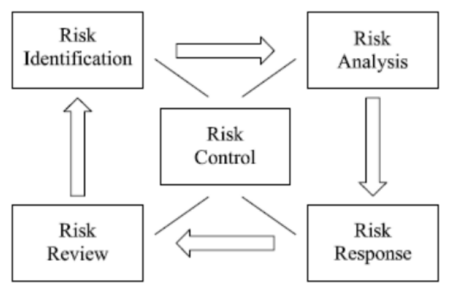Pro-active: Risk and Opportunity Management
Kittymaumau (Talk | contribs) |
Kittymaumau (Talk | contribs) |
||
| Line 20: | Line 20: | ||
== Identify risks == | == Identify risks == | ||
| − | The identification of risks has the purpose to determine if risk events occur whether they are positive or negative for the project. <ref name="Geraldi" /> For positive outcomes | + | The identification of risks has the purpose to determine if risk events occur whether they are positive or negative for the project. <ref name="Geraldi" /> For positive outcomes the event will be known as "opportunity" for the project, whereas the negative events is known as "threats" for the project. This can change the life cycle of the project process.<ref name="ISO" /> E.g. can a opportunity mitigate the time development of a certain product within the project or a delevery can be done more cost beneficial if two stakeholders within the porject collaborate. Here will the identification only analyse where events could occur but the assesment and treatment of the event is further steps in the process of risk control. |
== Assess risks == | == Assess risks == | ||
| Line 38: | Line 38: | ||
Version 1.0, Publisher: Dansk Standard </ref> | Version 1.0, Publisher: Dansk Standard </ref> | ||
<ref name="MEP4"> Geraldi, Joana and Thuesen, Christian (2017) Lecture from project management MEP-4, Publisher: Technical University of Denmark </ref> | <ref name="MEP4"> Geraldi, Joana and Thuesen, Christian (2017) Lecture from project management MEP-4, Publisher: Technical University of Denmark </ref> | ||
| + | <ref name="ISO"> Guidance on project management (2013) DS/ISO 21500 Version 2.0, Publisher: Dansk Standard </ref> | ||
Revision as of 09:17, 20 September 2017
Contents |
Abstract
Pro-active risk and opportunity management considers risk and opportunity events in a project with the purpose of mitigating the risk and enhance the opportunities before they occur. Risk events occur from uncertainties within a project whereas negative outcome is a risk for the project but positive outcomes can become opportunities for the stakeholders of the project.
A process/model to gain risk control for a pro-active risk and opportunity management is first identifying risks then assess the risks and last treat the risks which result in risk control. There is a fouth step to the process giving after treatment the risk management will be reviewed for analysing the success rate of the risk response/treatment.
Risk as deffinition is proberbility P times the impact I giving the formula:

Therefore is key elements in risk management the proberbility and impact that the events will occur and have. For pro-active risk management the key is then to manage these two values, done with different models and methods described further in the article, with the outcome of mitigated risk and enhanced opportunity events.
Introduction
For risk management there is in general four stages to ensure risk control the process is shown on figure 1. The four risk stages that form the risk control will be analysed with the perspective of pro-active risk and opportunity management.

For the first face in risk control the identification of the subject/risk event must be specified hereby will identify risks be analysed.
Identify risks
The identification of risks has the purpose to determine if risk events occur whether they are positive or negative for the project. [2] For positive outcomes the event will be known as "opportunity" for the project, whereas the negative events is known as "threats" for the project. This can change the life cycle of the project process.[3] E.g. can a opportunity mitigate the time development of a certain product within the project or a delevery can be done more cost beneficial if two stakeholders within the porject collaborate. Here will the identification only analyse where events could occur but the assesment and treatment of the event is further steps in the process of risk control.
Assess risks
The assessment of risks
Treat risks
The treatment considering the risks
References
- ↑ Geraldi, Joana and Thuesen, Christian (2017) Lecture from project management MEP-4, Publisher: Technical University of Denmark
- ↑ Geraldi, Joana and Thuesen, Christian and Stingl, Verena and Oehmen, Josef (2017) How to DO Projects? A Nordic Flavour to Managing Projects Version 1.0, Publisher: Dansk Standard
- ↑ Guidance on project management (2013) DS/ISO 21500 Version 2.0, Publisher: Dansk Standard